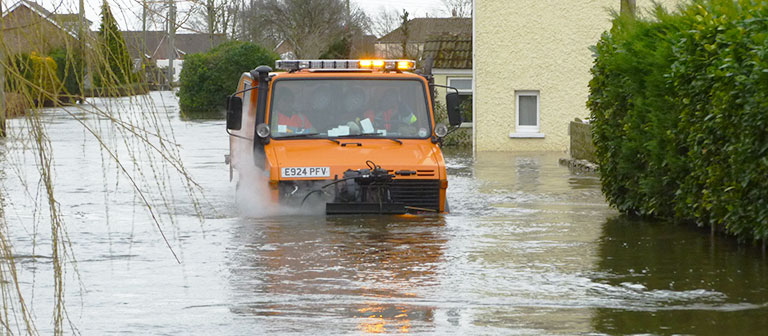7-point water level and flood risk management plan announced by ADA ahead of general election

In response to the general election announcement on 18 April, ADA has provided political leaders with seven key policy pointers to help reduce flood risk and deliver effective water level
management.
ADA, the representative body for drainage, water level and flood-risk management authorities, is ready to support the next government in managing and maintaining the water systems to the environmental and engineering standards expected. In return, it is looking for every political party to reflect and consider its position towards good water management.
Flooding and drought know no political or social boundaries and everyone in the UK is in some way affected by the management of water. As a foundation stone of society, it is essential that any government gives proper consideration to water level and flood risk management. Failure to do so, may result in considerable exposure to risk.
Henry Cator, ADA’s chairman said, “As Britain prepares to return to the polls, flooding and the management of water will very much be in the minds of many constituents in light of our changing climate, especially those effected by last year’s floods in the north of England.
“At the same time a dry spring is once again starting to bring Britain’s water resources into close focus. During the election campaign, ADA’s members and indeed the general public, will want to understand how each of the political parties plan to support effective and sustainable flood and water level management in the future.”
Mr Cator continues, “Over the next seven weeks ADA will work to help and ensure that all parties fully understand and engage with the issues facing the flood and water level management sector both now and post-Brexit.
“Many representatives from across the flood and water level management community will be gathering at the Floodex UK exhibition in Peterborough on the 17 and 18 May. We look forward to using this opportunity to discuss these ideas further with our members and any others involved in managing water.”
ADA’s seven key policy asks for better drainage, water level and flood risk management.
- Long term investment horizons – Flood risk management delivers enduring benefits, authorities involved need to be able to plan ahead financially over multiple years and need to receive a sensible balance of capital and revenue funding, spread across the river catchments, in order to find efficiencies and attract business investment.
- Promote co-operation and partnership working to manage the water environment and reduce flood risk – Close cooperation between flood risk management authorities, communities, business and land managers needs the continued strong support of government to deliver flood risk maintenance and similar activities more efficiently and affordably.
- Total catchment management – Now is the time to increase a catchment-wide approach to managing water from the highest points in our hills and mountains to our estuaries and lowland areas.
- Sustainable drainage systems (SuDS) – The next government needs to fully implement Schedule 3 of the Flood & Water Management Act 2010, to ensure future development can keep pace with the challenges of the changing climate, by ensuring that SuDS are maintained over the lifetime of a development.
- Support local governance in flood and water level management decision making – In some parts of England there is an appetite for greater local maintenance delivery on watercourses and flood defence assets than that currently afforded from national investment. This can be achieved via the careful transfer of some main river maintenance to local bodies, such as internal drainage boards, where there is local support and transitional funding.
- Local Government Business Rates Retention – It as vital that Special and Local Levy funding mechanisms for drainage, water level and flood risk management continue to be part of this funding landscape to maintain the democratic link with local communities affected.
- Brexit: Ensuring a resilient regulatory framework for the water environment – The next government needs to provide clear policy messages about how they wish to deliver environmental improvements to the water environment as we transition from European legislation such as the Water Framework Directive.
Archive
- April 2024
- March 2024
- January 2024
- December 2023
- November 2023
- October 2023
- September 2023
- August 2023
- July 2023
- June 2023
- May 2023
- April 2023
- March 2023
- February 2023
- January 2023
- December 2022
- September 2022
- August 2022
- July 2022
- June 2022
- May 2022
- April 2022
- March 2022
- February 2022
- January 2022
- December 2021
- November 2021
- September 2021
- July 2021
- May 2021
- March 2021
- February 2021
- January 2021
- December 2020
- November 2020
- October 2020
- September 2020
- August 2020
- July 2020
- May 2020
- April 2020
- March 2020
- February 2020
- January 2020
- December 2019
- November 2019
- October 2019
- September 2019
- August 2019
- July 2019
- June 2019
- May 2019
- April 2019
- March 2019
- February 2019
- January 2019
- December 2018
- November 2018
- October 2018
- September 2018
- August 2018
- July 2018
- June 2018
- May 2018
- April 2018
- March 2018
- February 2018
- January 2018
- December 2017
- November 2017
- October 2017
- September 2017
- August 2017
- July 2017
- June 2017
- May 2017
- April 2017
- March 2017
- February 2017
- January 2017
- October 2016
- September 2016
- August 2016
- July 2016
- June 2016
- May 2016
- April 2016
- March 2016
- January 2016
